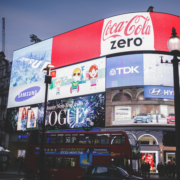Being creative is essential in producing an effective and memorable advertisement. Consumers are bombarded with thousands of ads a day. These ads come from the radio, television, social media, and signage outside of the home. How can you make sure your brand stands out from the rest? There are many ways marketing teams can get creative with their advertising campaigns. The most important and effective way is to implement a creative strategy in your advertising.

What is a Creative Strategy in Advertising?
In marketing, a creative strategy is a business’ outline in developing and implementing steps that support the business’ goals, objectives, and overall growth.
A creative strategy’s purpose is to align your brand, product, and marketing to steer your business towards growth. It will also outline your primary objectives, budget, calls to action, content, more.
Here are some steps to developing a good creative strategy:
It determines your target audience and their needs
A creative strategy will help you to identify the components of your marketing message and to who your message is being conveyed.
You want to spread your message to people who have potential interest in your brand or product offering, this is also known as your target audience.
By sending the message directly to people who want to hear it, you will avoid spending unnecessary resources spreading your message to those who don’t identify with it.
Once you determine your target audience, the next step is to do market research.
Market research will give you insights into what exactly your target audience wants from you. You want your marketing message to cater to the needs and wants of your potential customer.
It solidifies your message and call to action
When creating your marketing message, it’s important to align it with your brand’s identity, but it also needs a focal point.
What do you want your message to focus on? Product or service-based businesses should have their message focus on how they can best serve their audience or solve a specific problem.
Another factor to determine is your call-to-action (CTA). What response do you need from your audience to encourage a sale? Call-to-actions are usually innovative words or phrases that are incorporated into advertising messages that compel your audience to act in a specific way. The simplest examples include:
- Buy Now!
- Sign up today!
- Book Now
- Subscribe
It outlines objectives and success metrics
To gain proper insights into your campaign, it has to be measurable.
What metrics will you use to determine success? Will it be bounce rate, ROI, or customer retention? More importantly, breaking down goals into detailed objectives will not only clearly outline what needs to be done to reach the company’s overarching goal but will also break down unnecessary silos and state deliverables.

It explains the style, voice, and tone of your brand
A large part of running a business and creating and identifying your brand and its personality.
Brand identity has many elements including color schemes, logos, typography, imagery, and more. Strong brand identity will make consumers perceive your product or service offering as higher quality and allow you to build a loyal customer base.
We can use McDonald’s as an example. When we think of burgers and fries or see those Golden Arches on a red background, we immediately think of the fast-food chain. That’s because they possess a strong brand identity that allows consumers to quickly correlate specific products with their brand elements.
It outlines timeline and stakeholders
The purpose of implementing a creative strategy is to align the needs and goals of the business, which is why it requires high levels of collaboration.
Stakeholders from different areas of the business must play a role in developing your strategy. These stakeholders are the experts in their area of business and will be able to contribute innovative ideas and processes to move the business forward. The collaboration will result in greater consistency, meaning there are fewer barriers to aligned thinking.
Your creative strategy should also include a launch plan or timeline.
We recommend setting various milestones throughout the project. This will result in improved efficiency, better resource management, more manageable workloads, and greater transparency. Without specific milestone dates, you are more likely to put projects on the back burner which ultimately harms productivity and can ultimately delay your target launch. Additionally, a timeline will help team members stay on track and will prevent any last-minute problems.
Why is a Creative Strategy Important in Advertising?
Having a creative strategy in place is crucial to a successful marketing campaign.
Think of it as a blueprint of innovative approaches to meet larger company goals.
Implementing this long-term approach will put your business ahead of the curve.
Different Creative Strategies in Advertising
A creative strategy should be…well…creative. So, it will vary greatly, depending on your level of creativity and vision.
However, here are some pointers in how to develop a creative strategy so that it’s most successful (based on our experience):
Be responsive
Make sure you are always accessible whether that be via phone, email, or online chat.
Responsiveness is a great way to build trust with your customers. It shows them you are active and that there is support whenever they need it. It’s also important to understand your customer and their experience with your product or service.
Be catchy and memorable
Standing out from the competition will ensure people remember you and your product or service offering.
Use a catchy punchline or a captivating phrase that will allow customers to associate that specific slogan with your product. Let’s use the McDonald’s example again. The success of their “I’m lovin’ it” campaign, which launched in 2003, can be attributed to recognition and awareness. This slogan is known globally and has been McDonald’s longest-running brand slogan. When we hear, “I’m lovin’ it,” we immediately think of our favorite meal at McDonald’s.
Take advantage of OOH
In this digital age, billboards are often considered an “old” way of advertising.
However, the reason why they’re still around is that they work!
Billboards and other forms of outdoor advertising expose your message to a large audience, 24/7, making it cost-effective. Billboards are also one of the more trusted forms of advertising compared to digital advertising such as TV commercials and social media ads.
We are also seeing billboards go through a digital transformation.
Digital billboards don’t just live in Times Square anymore, you can find them all across the globe. Digital billboards offer an interactive edge compared to static billboards, so we’re shutting down the claims that billboards are an outdated method of advertising.

bMedia: Puerto Rico’s Advertising Experts
When it comes to outdoor advertising on the island, bMedia takes charge and we can even help you develop a creative strategy for your business.
Our highly qualified professionals understand what works and can provide you with the right tools to maximize your creative strategy’s impact.
bMedia is technology-driven and always thinks about innovative ways to excite customers and stimulate business growth.
With a network of over 500 locations in high-traffic areas, we guarantee we can get your message across loud and clear.
Contact us today, and together we’ll take your brand to new heights!










 787 792 4113
787 792 4113
